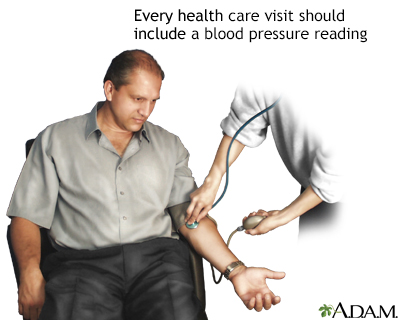Vital signs
Vital signs reflect essential body functions, including your heartbeat, breathing rate, temperature, and blood pressure. Your health care provider may measure, or monitor your vital signs to check your level of physical functioning.
Normal vital signs change with age, sex, weight, exercise capability, and overall health.
Normal vital sign ranges for the average healthy adult while resting are:
- Blood pressure: between 90/60 mmHg and 120/80 mmHg
- Breathing: 12 to 18 breaths per minute
- Pulse: 60 to 100 beats per minute
- Temperature: 97.8°F to 99.1°F (36.5°C to 37.3°C); average 98.6°F (37°C)
Reviewed By
Linda J. Vorvick, MD, Clinical Professor, Department of Family Medicine, UW Medicine, School of Medicine, University of Washington, Seattle, WA. Also reviewed by David C. Dugdale, MD, Medical Director, Brenda Conaway, Editorial Director, and the A.D.A.M. Editorial team.
Ball JW, Dains JE, Flynn JA, Solomon BS, Stewart RW. Vital signs and pain assessment. In: Ball JW, Dains JE, Flynn JA, Solomon BS, Stewart RW, eds. Seidel's Guide to Physical Examination. 10th ed. St Louis, MO: Elsevier; 2023:chap 6.
Simel DL. Approach to the patient: history and physical examination. In: Goldman L, Schafer AI, eds. Goldman-Cecil Medicine. 26th ed. Philadelphia, PA: Elsevier; 2020:chap 6.




